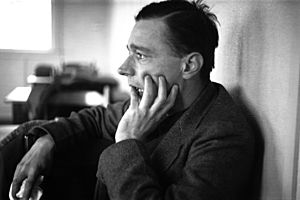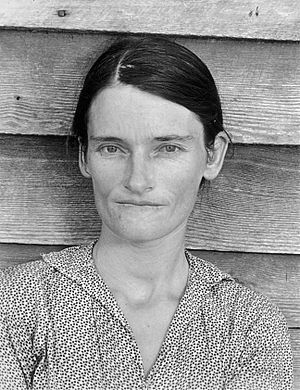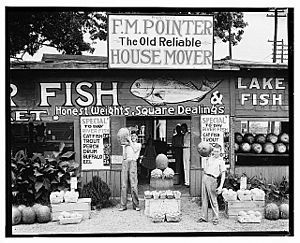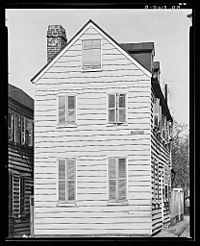Walker Evans facts for kids
Quick facts for kids
Walker Evans
|
|
|---|---|

Evans in 1937
|
|
| Born | November 3, 1903 St. Louis, Missouri, U.S.
|
| Died | April 10, 1975 (aged 71) New Haven, Connecticut, U.S.
|
| Nationality | American |
|
Notable work
|
American Photographs (1938) Let Us Now Praise Famous Men (1941) Many Are Called (1966) |
Walker Evans (born November 3, 1903 – died April 10, 1975) was a famous American photographer. He was known for his work as a photojournalist. He took many pictures for the Farm Security Administration (FSA). These photos showed how the Great Depression affected people.
Evans often used a special large camera for his photos. He wanted his pictures to be clear, powerful, and meaningful. Many of his photographs are now in museums. These include the Metropolitan Museum of Art and the George Eastman Museum.
Contents
About Walker Evans
Early Life and Photography Beginnings
Walker Evans was born in St. Louis, Missouri. His father worked in advertising. Walker grew up in a comfortable family. He lived in different cities like Toledo, Chicago, and New York City.
He went to schools like Phillips Academy. He also studied French literature at Williams College for a year. After that, he worked at the Public Library in New York. In 1926, he spent a year in Paris. When he came back, he joined a group of writers and artists in New York.
Evans started taking photos in 1928. He was inspired by other photographers like Eugène Atget. In 1930, some of his photos of the Brooklyn Bridge were in a poetry book. In 1931, he photographed old Victorian houses near Boston.
Photography in Cuba
In 1933, Evans traveled to Cuba. He was there to take pictures for a book called The Crime of Cuba. This book was about the government at the time.
Evans photographed everyday life on the streets. He showed police, people asking for help, and workers. He also helped writer Ernest Hemingway get photos for his own book. Evans made sure his photos were safe before he left Cuba.
Documenting the Great Depression
The years 1935 and 1936 were very important for Evans's photography. In 1935, he worked in West Virginia and Pennsylvania. He took a job with the U.S. Department of the Interior. He photographed a community built for unemployed coal miners.
Soon, he got a full-time job with the Resettlement Administration (RA). This agency later became the Farm Security Administration (FSA). It was part of a government plan called the New Deal. Evans took many photos for the FSA, mostly in the Southern United States.
In 1936, Evans worked with writer James Agee. They went to Hale County, Alabama. They spent time with three families who were sharecroppers. These families worked on land they did not own.
In 1941, Evans's photos and Agee's writing were published in a famous book. It was called Let Us Now Praise Famous Men. The book showed a very real picture of poverty in the countryside. Evans's photos of these families became symbols of the Great Depression.
Some family members later said they were upset. They felt the book made them look like they could not improve their lives. Evans continued to work for the FSA until 1938.
In 1938, the Museum of Modern Art in New York held an exhibition of his work. It was called Walker Evans: American Photographs. This was the first time the museum showed only one photographer's work.
Also in 1938, Evans started taking photos in the New York City Subway. He used a camera hidden in his coat. These photos were later put into a book called Many Are Called in 1966. Evans often had others make prints from his negatives. He would give them notes on how to print his photos.
Later Career and Final Works
Evans loved to read and write. In 1945, he became a writer for Time magazine. Later, he became an editor at Fortune magazine, where he worked until 1965. That year, he became a professor of photography at Yale University.
One of his last projects was photographing offices and partners for a bank. In 1973 and 1974, Evans used a new Polaroid SX-70 instant camera. This camera was easy and fast to use, which was helpful for him as he got older.
In 1971, the Museum of Modern Art held a big show of his photos. It was called Walker Evans. The show helped people see how his photos captured a strong sense of America.
Death and Lasting Impact
Walker Evans passed away in New Haven, Connecticut, in 1975.
In 1994, Walker Evans's family gave his collection of works to the Metropolitan Museum of Art in New York City. This museum now owns the copyright for most of his art. However, about 1,000 of his negatives are at the Library of Congress. These were made for the government and are now free for everyone to use.
In 2000, Walker Evans was honored. He was added to the St. Louis Walk of Fame.
Collections
- Art Institute of Chicago, Chicago, Illinois
- George Eastman Museum, Rochester, New York
- J. Paul Getty Museum, Los Angeles, California
- Metropolitan Museum of Art, New York City
- Museum of Modern Art, New York City
- Whitney Museum of American Art, New York City
- National Gallery of Victoria, Melbourne, Australia
- International Photography Hall of Fame, St. Louis, Missouri
See also
 In Spanish: Walker Evans para niños
In Spanish: Walker Evans para niños




